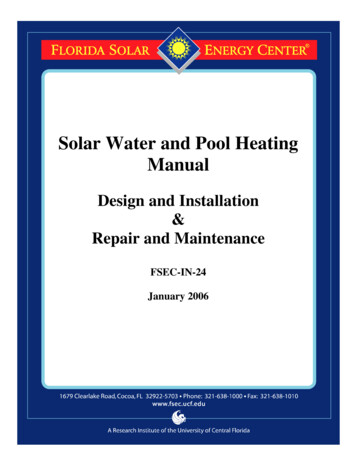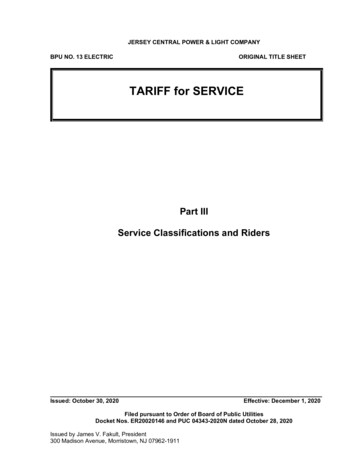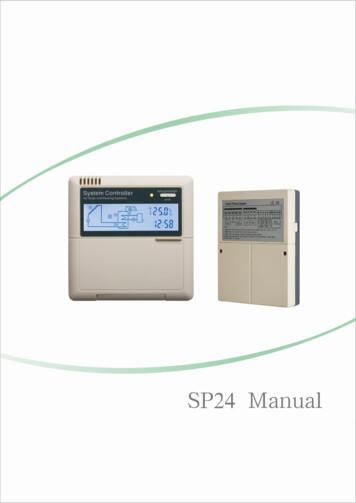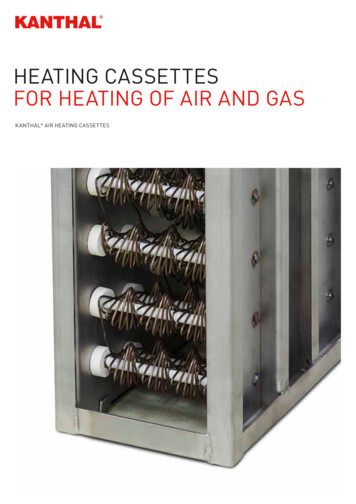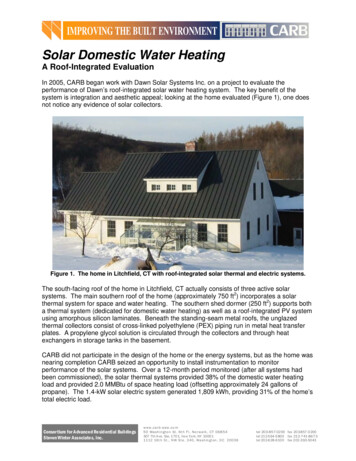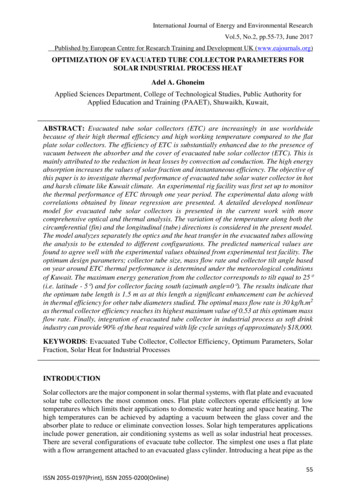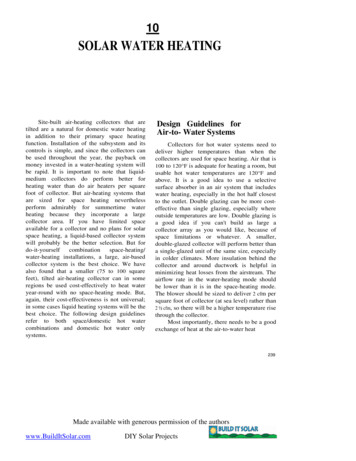
Transcription
Solar Water Heating ReportUCLA California Center for Sustainable Communities
Executive SummaryReducing greenhouse gas emissions from the residential housing sector is animportant part of California’s attempt to shrink its carbon footprint, and prioritizingthe most carbon intensive end-uses is essential to success. Residential water heatingin California represents a quarter of household energy consumption, and the vastmajority of residences use natural gas to heat water. Substantial energy savings canbe realized if the share of renewable energy used to heat water were increased. Thisanalysis explores the potential of community scale solar water heating systems toreduce residential natural gas consumption and generate energy savings.The Solar Water Heating Report is the first part of the larger analysis. This reportreviews the available solar thermal technologies and system types for community scalesolar water heating systems. The resulting community scale system design based onclimatic conditions, energy storage requirements, applicable building and energyefficiency codes, and cost. Based on these considerations, community scale systemsconsidered in this analysis will be closed, active systems with flat plate collector arrays.Determination of basic system characteristics is a prerequisite for estimating theirpotential energy savings.Table of ContentsExecutive Summary . 21 Introduction . 41.1 Background . 41.2 Natural Gas Consumption and Residential Water Heating . 41.3 Community Scale Approach to Solar Hot Water . 71.4 Benefits of Reduced Natural Gas Consumption . 91.5 Scope of This Report . 102 Solar Water Heating Components and Systems . 102.1 Solar Thermal Collectors . 112.2 Storage Tanks . 172.3 System Types . 182.4 System Scale . 202.5 Definition of Community Scale . 273 Review of Building and Industry Codes. 283.1 Industry Codes for System Components . 283.2 California State Building Code . 303.3 Los Angeles County Municipal Code . 333.4 Incentive Program Eligibility Requirements . 334 System Design for Community Scale SWH in Los Angeles County . 344.1 Solar Fraction Requirements . 344.2 Selection of Community Scale SWH Components . 355 Conclusion . 382
3
1 IntroductionThis report fulfills the Part 1 of Task 2 in the Community-Scale Solar Water HeatingProject scope of work. The Solar Hot Water Heating Report is the first deliverable ofTask 2.The goals of this task are to review existing solar water heating technologies and systems,and establish the basic system design and construction requirements for community-scalesolar water heating systems in Southern California. This report also assesses obstacles inapplicable product, building, and land use codes for solar thermal systems. The reportconcludes with recommendations for appropriate component technologies and a basicsystem design for community-scale solar water heating systems in Los Angeles County.1.1 BackgroundLimited availability of natural gas and abundant sunshine made solar water heating(SWH) systems an attractive choice for consumers during the end of the 19th and early20th centuries. 1 Prior to the 1930s, a limited natural gas distribution network and highenergy prices drove demand for domestic solar water heating systems. In 1897, one-thirdof homes in Pasadena had solar water heaters. 2 In the next several decades thousands ofadditional units were installed in California. 3,4 Consumers could heat water year-roundwithout having to use a stove, saving fuel and keeping residences cooler during thesummer months. 5During the 1930s, falling natural gas prices, urbanization, and incentives for consumersto switch to gas water heaters led to the displacement of solar thermal technology fromthe domestic market. 6 Fluctuations in energy prices during the 1970s and 1980s had amodest positive impact on demand for solar thermal, but as of 2009 more than 90% ofhouseholds in California have gas or electric water heaters. 71.2 Natural Gas Consumption for Residential Water HeatingCalifornia’s natural gas consumption patterns indicate that diminishing the amount ofnatural gas used for residential water heating is an effective strategy for reducinggreenhouse gas emissions from the residential housing sector. Table 1 shows that1Florida Solar Energy Center. (2006). Solar Water and Pool Heating Manual. Solar Water andPool Heating Manual, (January). Retrieved from http://www.fsec.ucf.edu2Islam, M. R., Sumathy, K., & Khan, S. U. (2012). Solar water heating systems and their markettrends. , P. (2007). The Technical Potential of Solar Water Heating to Reduce Fossil Fuel Useand Greenhouse Gas Emissions in the United States the Technical Potential of Solar WaterHeating to Reduce Fossil Fuel Use and Greenhouse Gas Emissions in the United States, (March),21. https://doi.org/NREL/TP-640-411574Islam, M. R., Sumathy, K., & Khan, S. U. (2012). Solar water heating systems and their markettrends. https://doi.org/10.1016/j.rser.2012.09.0115Florida Solar Energy Center. (2006). Solar Water and Pool Heating Manual. Solar Water andPool Heating Manual, (January). Retrieved from http://www.fsec.ucf.edu6Ibid.72009 California Residential Appliance Saturation Study, KEMA Inc.4
residential consumption represents approximately one-fifth of all natural gas deliveriesstatewide.Consumption CategoryResidentialCommercialIndustrialVehicle FuelElectric PowerTotal DeliveriesVolume of Natural Gas Delivered 7545,133,865Table 1: Natural Gas Deliveries by Consumption Category 1997-2016 (MM ft3) 8Percentage of TotalGas e water heating accounts for around 25% of total energy end use in residentialbuildings, water heating accounts for around 49% of residential natural gasconsumption 9,10. Additionally, 87% of residential buildings in California have gas waterheaters, making residential water heating a major source of natural gas consumption. 11Figure 1 shows annual natural gas consumption in residential buildings for the threelargest natural gas utility providers in California, broken down by water heating, spaceheating, and general base use. 12 Figure 2 shows statewide residential natural gasconsumption by end-use. 13 The proportion of total residential consumption representedby water heating suggests that a transition to a renewable sources of heat can yieldsignificant energy savings and reduce greenhouse gas emissions.8U.S. Energy Information Administration. (2017). California Natural Gas Consumption by EndUse 1997-2016 [Data set]. Retrieved from:https://www.eia.gov/dnav/ng/ng cons sum dcu SCA a.htm9U.S. Energy Information Administration. (2009). 2009 Residential Energy Consumption Survey[Data set]. Retrieved ata/2009/index.php?view microdata10Denholm, P. (2007). The Technical Potential of Solar Water Heating to Reduce Fossil Fuel Useand Greenhouse Gas Emissions in the United States The Technical Potential of Solar WaterHeating to Reduce Fossil Fuel Use and Greenhouse Gas Emissions in the United States, (March),21. https://doi.org/NREL/TP-640-4115711 2009 California Residential Appliance Saturation Study, KEMA Inc.12135Ibid.Ibid.
Figure 1: Residential natural gas consumption by for the three largest naturalgas utilities in California. 14Figure 2: Residential natural gas consumption by end use 1514156Ibid.Ibid.
1.3 Community Scale Approach to Solar Hot WaterThis report focuses on the energy savings and environmental benefits of community-scalesolar water heating systems. In this context, “community-scale” describes both the size ofthe system and an adherence to a set of design principles. Community scale systemsoccupy an intermediate space between the domestic and utility scales. This report definescommunity scale systems as those able to meet the hot water demands of tens ofresidential buildings up to hundreds of residential units with greater that the minimumsolar fraction required by law.Community scale energy systems are intended to make maximally efficient use of localresources where possible and create a range of options for residents to contribute to itsoperation. According to the CEC and National Renewable Energy Laboratory (NREL),community scale solar energy projects should include the following considerations. 16, 17 Primary Considerationso Make economically optimum use of local space and resources when andwhere possible.o Develop community scale energy infrastructure in a socioeconomicallyequitable manner. Secondary Considerationso Improved economies of saleo Improved project sitingo Exploration of new models for service delivery and project financing.A community scale approach to solar water heating in LA County is consonant with theconsiderations listed above. LA County has a mild, Mediterranean climate with abundantsunshine, but land use and development patterns range from densely populated urbanareas to near-rural exurbs. In places where residents cannot afford to install separatedomestic systems, or where space for system infrastructure is limited, a community scaleapproach offers opportunities for all participants to receive the benefits of solar waterheating and support their system’s operation. Residents may contribute by allowingsystem infrastructure to be installed on their property, or by contributing financially ifthey do not own property on which collectors or tanks can be placed.Studies of solar district heating in Northern Europe suggest that there are positive returnsto scale for solar water heating systems. Figure 3 shows that both the cost per unit heatdelivered and system cost per collector diminish as the total collector area of a districtsolar heating plant increases.16U.S. National Renewable Energy Lab. (2010). A Guide to Community Solar: Utility, Private,and Non-profit Project Development. Retrieved 7California Energy Commission. (2017). Renewable Energy Secure Communities. Retrievedfrom: ity.html7
Figure 3: Energy cost and system cost per collector vs. collector area fordistrict solar heating systems. 18A community scale approach to solar water heating may be superior in terms of economicefficiency to the installation of many smaller domestic solar water heating systems. Theproportion of the heat load supplied by solar energy, called the solar fraction of a system,depends on the amount of useful heat collected and the thermal losses from varioussystem components. 19 Larger systems require larger storage tanks, which store heat moreefficiently than numerous smaller tanks, thus diminishing the cost per unit heatdelivered. 20 Furthermore, community scale systems distribute fixed costs among manyusers, allowing residents who do not have the financial resources to install their own solarwater heating systems to enjoy low carbon hot water and reduce their consumption ofnatural gas. 2118U.S. Army Corps of Engineers. (2011). Central Solar Water Heating Systems Design Guide.Retrieved %20Systems.pdf19Duffie, J. A., & Beckman, W. A. (2013). Solar engineering of thermal processes. John Wiley& Sons.20Ibid.21Del Chiaro, B. & Telleen-Lawton, T. (2007). Solar Water Heating: How California CanReduce Its Dependence on Natural Gas. Environment California Research & Policy Center.Retrieved from: nment california swh.pdf8
1.4 Benefits of Reduced Gas ConsumptionReducing residential natural gas consumption will in turn reduce greenhouse gasemissions, diminish concentrations of local air pollutants (such as SO2 and NOx), andmitigate the likelihood of major fires and natural gas leaks.Given the share of natural gas deliveries consumed to heat water, the end use is anattractive target for reducing the greenhouse gas emissions from the residential housingsector. In 2016, California’s residential gas consumption for water heating totaled201,795 million cubic feet, resulting in the emission of eleven million tons of CO2. 22 Thisvolume of carbon dioxide is equal to that emitted annually by an American city with apopulation 700,000. 23 Since water heating accounts for 25% of residential energyconsumption, energy savings from an increased share of renewable heat are non-trivial.Reducing residential natural gas consumption will also reduce the probability andseverity of a catastrophic failure of LA County’s gas delivery and storage infrastructure.Accidental releases of methane, both large and small, increase California’s emissionsbudget and make achieving its climate goals more difficult. The 2015 Aliso Canyon GasLeak alone released 5 billion cubic feet of methane in 112 days, equivalent to the annualemissions of 600,000 cars. 24 The storage and transmission of methane leads inevitablyto releases that increase California’s emissions footprint.In addition to the environmental costs of leakages, a large earthquake in Los AngelesCounty could ignite numerous gas-fueled fires. A study by the California Seismic SafetyCommission estimated that 20-50% of fires resulting from a major earthquake (M 6.0)will be caused by the ignition of natural gas leaks. 25 Reducing residential demand fornatural gas will reduce the volume of gas that must be stored and delivered, mitigatingthe risk of leakages and fires.Finally, reducing natural gas consumption will yield public health benefits. Thecombustion of natural gas produces fewer co-pollutants (such as sulfur or mercury) thanthe burning of other fossil fuels, but it is still a source of NOx, CO, and other by-products22U.S. Energy Information Administration. (2017). California Natural Gas Consumption by EndUse 1997-2016 [Data set]. Retrieved from:https://www.eia.gov/dnav/ng/ng cons sum dcu SCA a.htm23European Commission Joint Research Centre - EDGAR. (2017). CO2 time series 1991-2015per capita for world countries [Data Set]. Retrieved from:http://edgar.jrc.ec.europa.eu/overview.php?v CO2ts pc1990-201524Michanowicz, D. R., Buonocore, J. J., Rowland, S. T., Konschnik, K. E., Goho, S. A., &Bernstein, A. S. (2017). A national assessment of underground natural gas storage: identifyingwells with designs likely vulnerable to a single-point-of-failure. Environmental Research Letters,12(6), 64004. ia Seismic Safety Commission. (2002). Improving Natural Gas Safety in Earthquakes.Retrieved SafetyReport%20w%20Figures%207-1502%20Version.pdf9
linked to respiratory and cardiovascular illnesses. 26 Burning less natural gas will reducelocal air pollution levels, improve public health, and reduce mortality.Residential use of natural gas also carries with it the risk of carbon monoxide (CO)poisoning. Improperly ventilated or malfunctioning water or space heating devices cancause potentially lethal levels of . From 1999-2010, non-fire related CO fatalitiesoccurred at a rate of 430 per year in the US. 27 Men and women over the age of 65 aremost likely to die from CO poisoning (0.42 and 0.18 deaths per 100,000 people,respectively). 281.5 Scope of This ReportThis report reviews the relevant component technologies for solar water heating systems,the industry and building codes relevant to their siting and construction, and designprinciples for large-scale solar thermal systems. Review of these topics will allow for thespecification of a basic solar water heating system design appropriate for residentialwater heating in LA County. The report will specify the following:1.2.3.4.Solar Collector Technology Type & Thermal EfficiencyEnergy Storage Time Horizon (i.e. Diurnal vs. Seasonal Storage)Auxiliary or Back-up Heat Source RequiredMethods for Predicting Solar Fraction and System PerformanceThis report will conclude with a basic description of the community scale solar waterheating system design for the purposes of this analysis. The system design criteria willinclude LA County’s climate, relevant state and municipal regulations, and cost.Establishment basic system characteristics is necessary prior to the estimation of energysavings in subsequent case studies. Other parameters that affect system performance,such as collector areas and system volumes, will be determined on a case-by-case basis,since available space for system infrastructure will differ between case study sites.2 Solar Water Heating Components and SystemsThe fundamental elements of solar water heating systems include solar thermalcollectors, storage tanks (to store the heated working fluid/ heated water), and pipingsystems to move heated water and working fluid between collectors, storage tanks, andbuildings. Additional elements may include heat exchangers, auxiliary gas heaters, buffertanks, and seasonal heat storage systems. Control mechanisms for solar water heating26Haines, A., McMichael, A. J., Smith, K. R., Roberts, I., Woodcock, J., Markandya, A., Wilkinson, P. (2009). Health and Climate Change 6 Public health benefits of strategies to reducegreenhouse-gas emissions: overview and implications for policy makers. The Lancet, 374, 2104–2114. https://doi.org/10.1016/S014027Centers for Disease Control and Prevention. (2014). QuickStats: Average Annual Number ofDeaths and Death Rates from Unintentional, Non-fire Related Carbon Monoxide Poisoning bySex and Age Group – United States, 1999-2010. Retrieved 303a6.htm28 Ibid.10
systems depend on a given system’s size and complexity. 29 The sections below discussthe purposes and working principles of solar water heating systems’ component parts.2.1 Solar Thermal CollectorsSolar thermal collectors absorb thermal energy from incident solar radiation, and transferto water or a working fluid. The four most common collector types are: Flat Plate Collectors (FPCs)Evacuated Tube Collectors (ETCs)Integral Collector-Storage Systems (ICSS)Integrated Photovoltaic/ Thermal (PV/T) CollectorsSelection of a collector type depends on the desired application and cost. The amount ofuseful heat a collector delivers to a given system is a function of the amount of incidentsolar radiation, the difference between ambient temperature and that of the unit, and thetemperature of the heat transfer fluid at the collector inlet. 30 Collector performance is alsoaffected by the angle of insulation and local meteorological conditions. 31 Table 1 lists thepeak thermal efficiencies for different collector types measured in laboratory settings.– Peak thermalmeasuring useful heat outputobtained from a fixed amount of incident radiation and an ambient temperature equal tocollector inlet temperature (Ti Ta).Table 2:Thermal Efficiencyof re arebasedon laboratorystudiesCollector TypeFlat PlateEvacuated TubePV/T29Peak Thermal Efficiency (Ti Ta)70-80% 32, 33 60% 3450-70% 35Fisch, M. N., Guigas, M., & Dalenbäck, J.-O. (1998). A review of large-scale solar heatingsystems in Europe. Solar Energy, 63(6), 355–366. https://doi.org/10.1016/S0038092X(98)00103-030 Duffie, J. A., & Beckman, W. A. (2013). Solar engineering of thermal processes. John Wiley& Sons.31Ibid.32Zondag, H. A. (2008). Flat-plate PV-Thermal collectors and systems: A review. Renewable andSustainable Energy Reviews. , L. M., Duffy, A., Mc Keever, M., Conlon, M., & Mccormack, S. J. (2011).Comparative field performance study of flat plate and heat pipe evacuated tube collectors (ETCs)for domestic water heating systems in a temperate 3434Ibid.35Dubey, S., & Tiwari, G. N. (2008). Thermal modeling of a combined system of photovoltaicthermal (PV/T) solar water heater. Solar Energy. https://doi.org/10.1016/j.solener.2008.02.00511
Integrated Collector StorageVariable 36Flat Plate Collectors (FPCs)A flat plate collector is an insulated box containing an absorber plate and a network offlow tubes covered by a sheet of translucent glass or plastic. Most FPCs have copper flowtubes and absorber plates with selective coatings to reduce reflection. 37FPCs transfer heat to water or a working fluid as it passes through the network of flowtubes in thermal contact with the absorber plate. The translucent cover serves to reduceheat losses from convection. Figure 2 shows a typical FPC design.Figure 4: Flat Plate Solar Collector 3836Smyth, M., Eames, P. C., & Norton, B. (2006). Integrated collector storage solar water heaters.Renewable and Sustainable Energy Reviews, 10(6), 0137 Duffie, J. A., & Beckman, W. A. (2013). Solar engineering of thermal processes. John Wiley& Sons.38 https://www.designingbuildings.co.uk12
Stud results in a thermal efficiency of approximately 75% 39 This should be considered anupper limit on the thermal efficiency of a flat plate collector, as their thermal efficienciesare sensitive to changes in ambient temperature. 40,41 The Drake’s Landing, in Northerncoastal California, solar community project, which uses and array of 800 flat plate panelsto provide space and water heating, has documented a thermal efficiency range for thecollection system (collectors and pipes) between 30-70%, with an average ofapproximately 50%. 42Evacuated Tube CollectorsEvacuated tube collectors consist of an array of evacuated glass tubes, each containing asmaller glass tube within. The inner glass tube houses an absorber plate in thermalcontact with a flow tube. A vacuum between the two glass layers serves to thermallyinsulate the inner tube.Figure 5: Evacuated Tube Solar Collector39Zambolin, E., & Del Col, D. (2010). Experimental analysis of thermal performance of flat plateand evacuated tube solar collectors in stationary standard and daily conditions. SolarEnergy, 84(8), 1382-1396.40Ibid.41Ibid.42Sibbitt, B., McClenahan, D., Djebbar, R., Thornton, J., Wong, B., Carriere, J., & Kokko, J.(2012). The performance of a high solar fraction seasonal storage district heating system - Fiveyears of operation. Energy Procedia, 30, 856–865. https://doi.org/10.1016/j.egypro.2012.11.09713
There are two main types of evacuated tube collector designs, but all designs employabsorptive coatings on the surface of either the inner tube wall or the absorber plate.Some evacuated tube collector designs include heat pipes that terminate in heat bulbs,around which water flows through a heat exchange manifold. Alternatively, directcirculation designs circulate a working fluid through u-shaped pipes within each of theinner tubes, and return the heated fluid to a header pipe.A comparative study of flat plate and direct circulation evacuated tube collectors’ thermalefficiencies found that evacuated tube collectors have slightly lower peak thermalefficiencies than flat plate collectors ( 60%), but are less sensitive to changes in ambienttemperature and the direction of incident solar radiation. 43 Evacuated tube collectors aremore efficient over a greater range of meteorological conditions and temperatures thanflat plate designs. 44 The superior thermal performance of ETCs in variable weatherconditions is also supported by data from a study domestic solar water heating systems inDublin, Ireland. 45 ETC systems had greater average annual solar fractions (50.3%) thanFPC systems (37.9%). 46Integral Collector Storage System (ICSS)Integral collector storage systems are the oldest and simplest type of solar thermalcollector technology. 47 Integral collector storage systems store heated water within thesolar thermal collection device, rather than in a separate tank (i.e. a distributed system). 48A wide variety of designs for integral collector storage systems exist. Integral collectorstorage systems may employ a flat plate design with storage tanks instead of flow tubes,use a series of evacuated tubes that terminate in a storage tank, or employ reflectors andphase-change materials to maximize heat absorption and minimize thermal losses. 49Zambolin, E., & Del Col, D. (2010). Experimental analysis of thermal performance of flatplate and evacuated tube solar collectors in stationary standard and daily conditions. SolarEnergy, 84(8), 1382–1396. https://doi.org/10.1016/j.solener.2010.04.02044 Ibid.45 Ayompe, L. M., Duffy, A., Mc Keever, M., Conlon, M., & McCormack, S. J. (2011).Comparative field performance study of flat plate and heat pipe evacuated tube collectors (ETCs)for domestic water heating systems in a temperate climate. Energy, 36(5), 3370-3378.46 Ibid.47 Smyth, M., Eames, P. C., & Norton, B. (2006). Integrated collector storage solar waterheaters. Renewable and Sustainable Energy Reviews, 10(6), 503-538.48 Ibid.49 Ibid.4314
Figure 6: Integrated Solar Collector Storage System 50Integral collector storage systems generally suffer greater thermal losses during nighttimeand non-operative periods than distributed systems. 51 Distributed systems featurephysically separate storage and collector equipment to minimize thermal losses andimprove storage efficiency. Thermal efficiencies vary widely based on the specificcollector/storage design used in a given implementation. ICSSs are most often used topre-heat potable water for a single residence. 52 Pre-heated water is then brought up to thedesired delivery temperature with a conventional gas or electric water heater.Integrated PV/T CollectorsIntegrated PV/T collectors couple the generation of electric current from photovoltaicsolar cells with the collection thermal energy for water and space heating. The conversionof solar energy into electric current via the photoelectric effect is a process which is arelatively inefficient process that produces a large amount of waste heat. The collectionof waste heat from PV cell arrays both increases the efficiency of the cells s.com/images/stories/heating/alt39.gifIbid.52 Smyth, M., Eames, P. C., & Norton, B. (2006). Integrated collector storage solar water heaters.Renewable and Sustainable Energy Reviews, 10(6), 503-538.5115
(which diminishes as their temperature increases) and provides thermal energy for spaceand water heating. 53Figure 7: PV/T Cell 54A myriad of PV/T collector designs exist, but all systems involve the circulation a fluidcoolant to collect waste heat from photovoltaic cells. PV/T collectors may include atranslucent housing or cover to increase thermal absorptivity. 55 Theoretically, PV/Ttechnology is be the most efficient method for collecting solar energy. High-performingPV/T cells could potentially obviate the need for separate photovoltaic and thermalsystems. However, the lower thermal performance of PV/T systems relative to other solarthermal collectors has limited PV/T’s adoption. 56 PV/T systems collect solar thermalenergy indirectly, only about 75% of incident solar energy is available in the form ofHuang, B. J., Lin, T. H., Hung, W. C., & Sun, F. S. (2001). Performance evaluation of solarphotovoltaic/thermal systems. Solar Energy, 70(5), 153-554 Chow, T. T. (2010). A review on photovoltaic/thermal hybrid solar technology. AppliedEnergy, 87(2), 365–379. https://doi.org/10.1016/j.apenergy.2009.06.03755 Ibid.56Dupeyrat, P., Menezo, C., & Fortuin, S. (2014). Study of the thermal and electricalperformances of PVT solar hot water system. Energy and Buildings, 68(PART C), 9.0325316
heat. Maximum thermal efficiencies for PV/T solar collectors range from 50-70%. 57, 58Like the other collector technologies discussed previously, thermal efficiencies of PV/Tcollectors vary depending on ambient temperature, meteorological conditions, and theangl
1 Prior to the 1930s, a limited natural gas distribution network and high energy prices drove demand for domestic solar water heating systems. In 1897, one-third of homes in Pasadena had solar water heaters.2 In the next several decades thousands of additional units were installed in California.3,4 Consumers could heat water year-round without having to use a stove, saving fuel and keeping .

